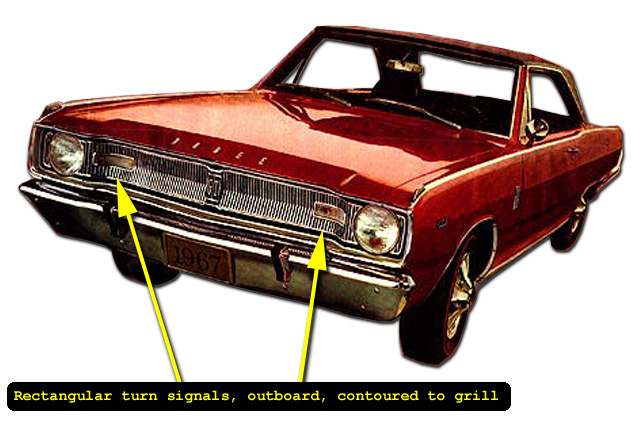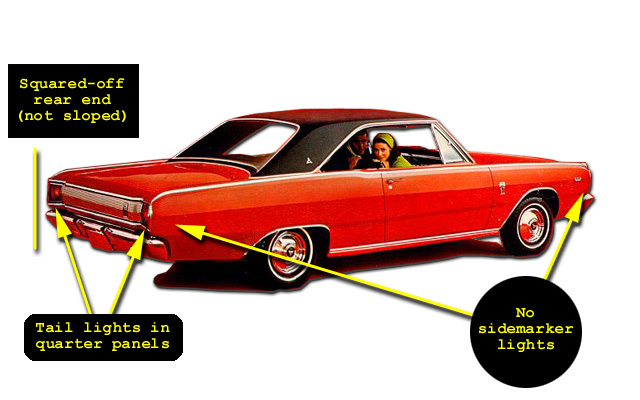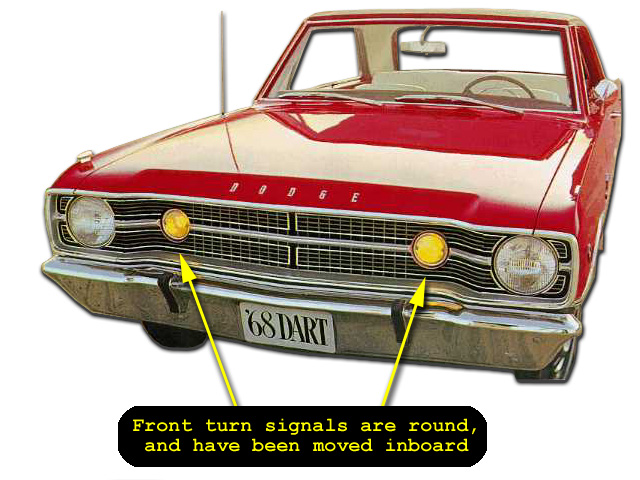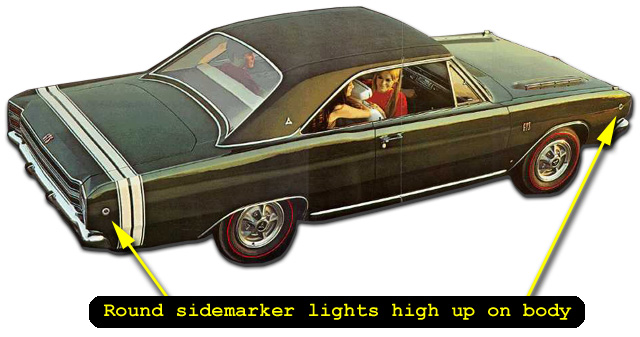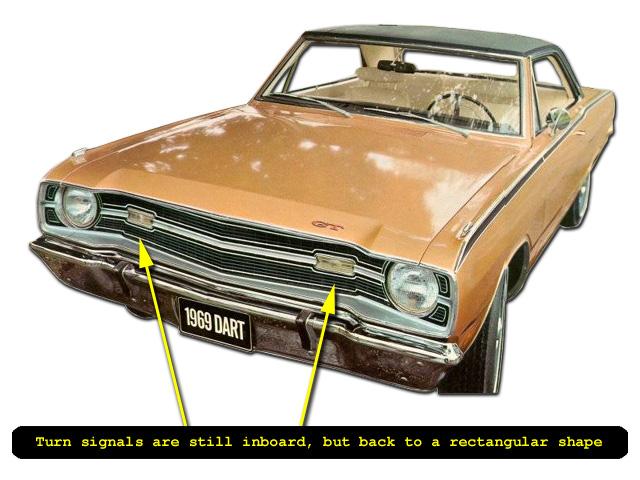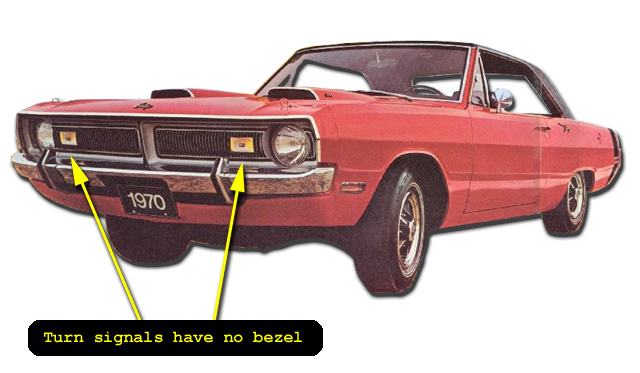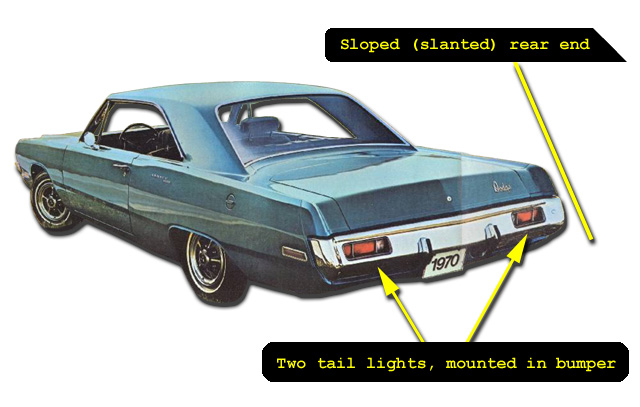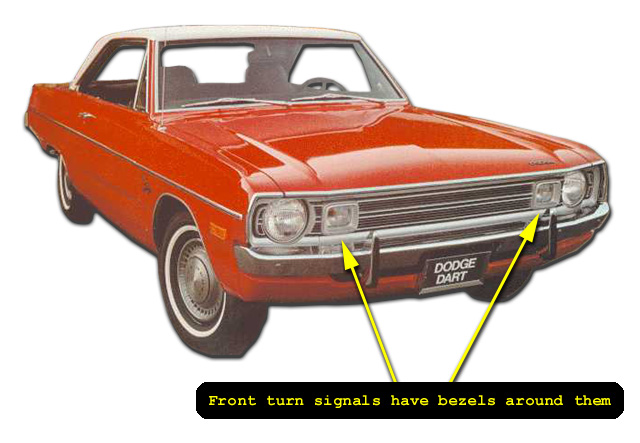1967-1972 Dodge Dart Identification Guide
In 1967, Dodge drastically changed the styling of the Dart from the
previous year, and the
basic shape of this revamped Dart was used up through the end of production in 1976.
This page describes the changes
that took place from year to year (through 1972), which can be used to visually
identify the model year of a particular Dart.
The most accurate way to identify the vintage of a particular
Dart in this model year range is to just look at the VIN. It will
have 13 digits, and the 6th digit from the left is the year. If it is
a 7, its a 1967, 8 is 1968, 9 is 1969, 0 is 1970, 1 is 1971 and 2 is
1972. Of course, the VIN information isn't always available, for
example perhaps you are trying to identify a car which is driving down
the street or one in a photograph. This is where knowing the
differences from year to year will come in handy. However, be aware
that because Darts in the 1968 through 1972 range have more
similarities than differences, it is possible to essentially transform any given Dart into
one that matches a different model year. How difficult this
transformation would be depends on which year you are starting from
and which year you want to end up at. Some transformations would be
extremely easy; for example to make a 1971 look like a 1972 (or vice
versa) merely requires swapping out the turn signals (along with the
grills, probably).
Likewise, the line between a 1970 and 1971 can be blurred with a
rear bumper swap. So, just be
aware that although being able to visually identify the model year of
a particular Dart is helpful, you can never be completely sure unless
you verify your diagnosis against the VIN. If you want to get
really technical about this stuff, since it is physically possible
(although illegal)
to mess with the VIN plate, even that step may not eliminate all
possibility for error.
1967
1967 Highlights:
- Totally changed styling from the previous year, this is the
first year of the basic "1967 through 1972 shape".
- Rectangular front turn signals which are positioned outboard
(they are nestled up against the headlights, and follow the contour of
the grill)
- No sidemarker lights
Features unique to the 1967 Dart (as compared to all other 1967-1972 style Darts):
- No sidemarker lights at all
- Rectangular front turn signals which follow the contour of the grill
Identification Process:
- The recessed front grill and squared off rear end with tail
lights mounted in the quarter panels narrows it down to 1967-1969
- The rectangular, outboard turn signals which follow the contour of the
grill identify it as a 1967.
- The lack of sidemarker lights provide further confirmation that it is a 1967
(The fact that it has no sidemarker lights is actually enough to
ID it as a 1967 in one step. Likewise, the fact that the turn signals
follow the contour of the grill is also enough to identify it as a
1967 in one step.)
The distinguishing feature of the 1967 Dart's front end is the turn signals,
which are rectangular in shape and are in an outboard position, almost right up against the
headlights. Notice how they actually match the curve of the grill as
they reach out to try and touch the headlights.
The rear end of the 1967 Dart is basically squared off from front to
back (it does not slope like the 1970+ models), and the tail lights are
located in the back of the quarter panels (as opposed to in the bumper
like the 1970+ models).
Notice also that there are no sidemarker lights in the fenders or
quarter panels. The 1967 Dart is the only one in this body style
to not have these lights.
1968
1968 Highlights:
- Round front turn signals which have been moved slightly
inboard (away from the headlights)
- Round sidemarker lights in the fenders and quarter
panels
Features unique to the 1968 Dart (as compared to all other 1967-1972 style Darts):
- Round turn signals
- Round sidemarker lights
Identification Process:
- The recessed front grill and squared off rear end with tail
lights mounted in the quarter panels narrows it down to 1967-1969
- The round, inboard turn signals identify it as a 1968
- The round sidemarker lights provide further confirmation that
it is a 1968
(The fact that it has round turn signals is actually enough
to ID it as a 1968 in one step. Likewise, the fact that it has round sidemarker lights is
also enough to ID it as a 1968 in one step.)
1968 saw the addition of sidemarker
lights in the fenders and quarter panels. These sidemarker lights are
round and are located high on the body, a little higher than midway up
the car. Also, the front turn signals were moved inboard a bit (away
from the headlights) and were changed to a round shape instead of
rectangular.
1969
1969 Highlights:
- Turn signals still inboard, but rectangular instead of round
- Sidemarker lights moved lower on body and are rectangular instead of
round
Features unique to the 1969 Dart (as compared to all other 1967-1972 style Darts):
Identification Process:
- The recessed front grill and squared off rear end with tail
lights mounted in the quarter panels narrows it down to 1967-1969
- The rectangular, inboard turn signals identify it as a
1969
- The rectangular sidemarker lights provide further confirmation
that it is a 1969
Ironically, the two main changes that marked the switch from 1967 to
1968 (turn signals and side marker lights) are also the major players
in the transformation from 1968 to 1969. If 1968 was the year that made
the Dart's world "go round", then 1969 must be the year that it became
"hip to be square", because both the turn signals and the sidemarker lights
changed from round to rectangular.
The 1969 rectangular turn signals are still different from the 1967's
rectangular turn signals though, because although the shape changed
back to rectangular, they stayed in the same basic position as the
1968 turn signals (inboard). Note that they are further away from the
headlights than the 1967 turn signals are, and they do not follow the
contour of the grill like the 1967 turn signals do.
As far as the sidemarker lights in the fenders and quarter panels are
concerned, besides changing shape from round to rectangular, they were
moved much lower on the body.
1970
1970 Highlights:
- Major front end restyling
- Major rear end restyling
Features unique to the 1970 Dart (as compared to all other 1967-1972 style Darts):
- Two rectangular tail lights mounted in the bumper
Identification Process:
- The protruding front grill and sloping rear end with tail
lights mounted in the bumper narrows it down to 1970-1972
- The lack of a bezel around the front turn signals narrows it down to
1970-1971
- Having only two tail lights identifies it as a 1970
(The fact that it has two tail lights mounted in the
bumper is actually enough to ID it as a 1970 in one step, I only
mention the lack of bezels around the front turn signals in case your
only view of the car is from the front; you can at least narrow it
down from three years to two.)
1970 brings a major styling change to the Dart linup.
Although the 1967 through 1972 Darts have a very similar body shape,
they can easily be divided into two groups; 1967-1969 and 1970-1972.
Although the basic body shape remained the same, both ends of the car
underwent some drastic changes.
The front end was changed to what I sometimes refer to as the "scowl"
because if you're at the right angle (looking down at the front of the
car), the protruding hood and fenders cover the tops of the
headlights, giving the car the appearance as if it is scowling, or
glaring at you. Its a
great look, and I think this style of front end is my favorite because
it is more of a "muscle" look as compared to the relatively sedate
"family car" vibe of the 1967-1969 models. (Viewed from other angles, this
new Dart front end has a
look somewhat reminiscent of the 1970 Barracuda.) In the 1967 through
1969 Darts, the headlights are basically protruding, and the middle of
the grill is sunk in. Its the opposite for the 1970 through 1972
models; the middle of the grill is pushed out, and it is the
headlights which are recessed.
The changes to the back of the car were just as drastic
as those in the front. Instead of the basically squared off rear end (when
viewed from the side), it now has an angle to it, sloping down from
front to back. (The popular Scat Pack bumblebee stripe which is
slanted to match compliments the car very nicely.)
The slanted rear end gives gives the car a feeling of motion even
when its standing still, although this look came at
the expense of a decrease in trunk space. Another obvious
change to the rear end is that the tail lights are no longer a
square-ish shape mounted in the quarter panel sheet metal,
they are now rectangular, and mounted in the bumper.
1971
1971 Highlights:
- Four tail lights (instead of two) mounted in the rear bumper
Features unique to the 1971 Dart (as compared to all other 1967-1972 style Darts):
Identification Process:
- The protruding front grill and sloping rear end with tail
lights mounted in the bumper narrows it down to 1970-1972
- Having four tail lights mounted in the bumper narrows it down to
1971-1972
- Having turn signals which do not have a raised ridge or bezel
around them narrows it down to a 1971
The only major styling difference from 1970 to 1971 is at the back of
the car; the front end stayed the same.
The 1970 Dart had two large rectangular tail lights mounted in the bumper.
The 1971 tail lights are still rectangular, but they are smaller and
there are now four of them instead of two. The reverse
lamps are located in the centers of the innermost set of tail lights.
The 1970 and 1971 Darts are
the only ones (from 1967 to 1972) that you need to get behind
to positively identify. All of the other years have something unique
about their front end which allows you to tell what year it is from
the front alone. You can narrow it down to 1970 or 1971 from the
front, but to take it any further you'll need to walk around behind
the car and look at the bumper.
1972
1972 Highlights:
- Front turn signals have a raised edge or bezel around them
Features unique to the 1972 Dart (as compared to all other 1967-1972 style Darts):
- Front turn signals have a raised edge or bezel around them
Identification Process:
- The protruding front grill and sloping rear end with tail
lights mounted in the bumper narrows it down to 1970-1972
- Having four tail lights instead of two narrows it down to
1971-1972
- Having turn signals which have a raised ridge or bezel
around them narrows it down to a 1972
(The fact that it has a raised edge or bezel around
the turn signals is actually enough to ID it as a 1972 in one step.)
Not much was changed between 1971 and 1972 with regards to exterior
styling. The rear end stayed the same, but you can distinguish a the
two from the front. The turn signals are slightly different than
on the 1970 and 1971 models in that they have a prominent ridge or
raised bezel surrounding them. Also, the grill is no longer split by
a vertical bar in the middle.
1967-1972 Dodge Dart
Identification Guide
